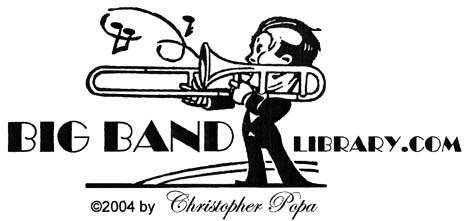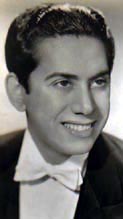
vital stats:
given name Carmelo Cavallaro
birth May 6, 1913, New York, NY
death Oct. 12, 1989, Columbus, OH, cancer
heritage Italian
sister
wife Donna
daughters Dolores; Anita
sons Paul; Charles; Frederick; Robert
grandchildren six
membership ASCAP, 1957-
residence Columbus, OH, 1974-
"When I was 3 years old my mother had gotten me a toy piano," Cavallaro later recalled. "She used to save soap coupons, and the premium happened to be a toy piano. Before long I was picking out arias my dad used to listen to on Caruso records."
In 1939, Cavallaro opened - to little fanfare - with a small group (bass, guitar, and drums) at the Statler Hotel in St. Louis.
But not long afterwards, he was doing a party with a pickup band at a Long Island country club. An official from Decca heard him and invited him to record some popular standards, including Dancing in the Dark, Alone Together, and You're Mine, You, for a 78-rpm album that became, to use a showbiz term, "a sleeper."
"There was little advance publicity on the album and its tremendous acclaim was due almost entirely to spontaneous word-of-mouth advertising," it was later observed.
As his fame spread, Cavallaro was hired to appear at top dining and dancing rooms, hotels, and clubs across the country, such as the Waldorf and Astor in New York City, the Drake and Palmer House in Chicago, and the Ritz Carlton and Steel Pier in Atlantic City.
In 1940, he enlarged his group to 8 pieces, then to a full-sized orchestra in the mid-'40s, but eventually cut back to a trio.
Carmen Cavallaro in His Own Words
"The trend has been toward small groups in every kind of music . . . Rock 'n' roll, jazz,
whatever - it's small groups now."
"I haven't played dance music since 1950. I've gotten used to a situation in which a big
spotlight hits me in the middle of the floor. The audience pays attention. The prestige of
getting up front as a soloist is lost if you're playing with a band."
"Some of today's music is good, but most is lousy . . . But then . . . that really isn't
different from the old days."
Cavallaro continued to record for Decca for some 30 years.
His interpretation of Chopin's Polonaise, made on March 30, 1945, sold a million copies, thereby becoming a "gold record."
In 1956, Cavallaro won acclaim for his imitation of Eddy Duchin's piano style on the soundtrack of the film "The Eddy Duchin Story," which starred Tyrone Power and Kim Novak. Decca released a soundtrack disc and when, after four years, it topped a million in sales Leonard Schneider, Executive Vice-President with the label, handed Cavallaro a gold record award in recognition of that achievement.
Cavallaro evidently had a say in the artwork used on his album jackets. He commented that he rejected an elegant oil painting which depicted him "smiling like an idiot," intended for a 1960 release, "The Franz Liszt Story" (Decca DL 78999).
"It was in the late '30s that Carmen was a dashing bandleader-pianist in the Mayfair room of fond memory, in the early '40s that he glistened in the Empire room," Will Leonard reminisced in the Chicago Daily Tribune in 1958. "He's no longer a maestro, but he still is a bard of the keyboard, heading a highly musical quartet. Then there's a touch of gray at the temples, the big, powerful Cavallaro fingers are nimbler than ever, the music from his quartet more persuasive than when he led a big aggregation."
As Cavallaro flew to different jobs, he took along a reported 500 pounds of luggage, explaining that he had to have clothes for any climate. (A check of his early 1960 itinerary included The Blue Room of the Shoreham Hotel in Washington, D.C. and, prior to that, stops in New Orleans, Puerto Rico, and Miami.)
"In his traveling gear are three tuxedos, three business suits, four pairs of slacks, two sports coats, over two dozen shirts, bathing trunks, and two top coats," newspaper reporter Winzola McLendon noted.
He remained on the road for weeks at a time and, starting in 1962, performed in Japan every year for the next two decades.
In 1980, he traveled across the U.S. as a cast member of "The Big Broadcast of 1944," a revue which recreated a 1940s radio variety program.
Looking back, he said that a fond highlight of his career was when he was asked to play at the White House in Washington, DC for President Dwight Eisenhower.
You could say that Cavallaro always had the world at his fingertips.
sources:
"Cavallaro, Carmen, " in ASCAP Biographical Dictionary, Fourth Edition (New York, NY:
R.R. Bowker Company, 1980), p.81.
Gerald Etter, "Cavallaro: 'Today's music is good, but . . .'," Chicago Tribune, Feb. 24, 1981,
p.B6.
Charles Garrod, Carmen Cavallaro and His Orchestra (Zephyrhills, FL: Joyce Record Club,
1989).
Larry Kart, "Variety: 'Big Broadcast of 1944' sends out delightful signal," Chicago
Tribune, June 13, 1980, p.B10.
Roger D. Kinkle, "Cavallaro, Carmen," in The Complete Encyclopedia of Popular Music
and Jazz 1900-1950: Volume 2 Biographies A Through K (New Rochelle, NY: Arlington
House Publishers, 1974), pp.695-696.
Will Leonard, "On the Town: Carmen Cavallaro Fills Bill as a Swoon Boy for Mature Girls,"
Chicago Daily Tribune, Mar. 2, 1958, p.E11.
Winzola McLendon, "Revolutions Not All Turntable Type: 'Poet of Piano' Is Hexed,"
Washington Post, Times Herald, Feb. 10, 1960, p.C3.
OCLC WorldCat database.
"Ohio Deaths: Carmen Cavallaro, Big Band pianist," Cleveland [ OH ] Plain Dealer,
Oct. 14, 1989.
"On the Town: Carmen's Back Playing On and On," Washington Post, Times Herald,
Feb. 17, 1961, p.C7.
John Pagones, "On the Town: Sounds of Carmen Cavallaro Remain Ever the Same,"
Washington Post, Times Herald, May 18, 1962, p.D5.
John S. Wilson, "Carmen Cavallaro Splits Show Between Dancing and Listening,"
New York Times, June 16, 1966, p.52.
I would like to expand this tribute with, if possible, a new interview of someone who was important to Carmen Cavallaro's life or career. Are you an alumnus of his band, a member of his family, or a collector who is knowledgeable about his accomplishments? Please contact me via e-mail
return to "Biographical Sketches" directory
go to Big Band Library homepage
The big bands are back
in a new and exciting way!
CARMEN CAVALLARO
"THE POET OF THE PIANO"
by Music Librarian CHRISTOPHER POPA
October 2008
He was a skilled pianist who could play with a gentle, fluid touch and stick close to the melody or he could embellish the music with a dazzling technique, incorporating glissandos (a rapid slide through the pitches of the piano) and different (for example, Afro-Cuban) rhythms.
Included in his repertoire were such varied pieces as Enlloro (Voodoo Moon), Warsaw Concerto, Body and Soul, All the Things You Are, and Rhapsody in Blue, along with several pop tunes of the moment.
He handled the pacing of his shows well, changing the mood from a ballad to an upbeat number with ease.
a 1940s portrait by
Bruno of Hollywood
